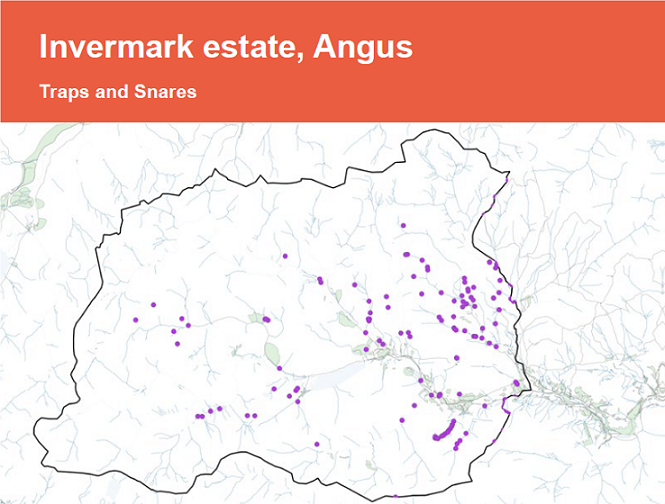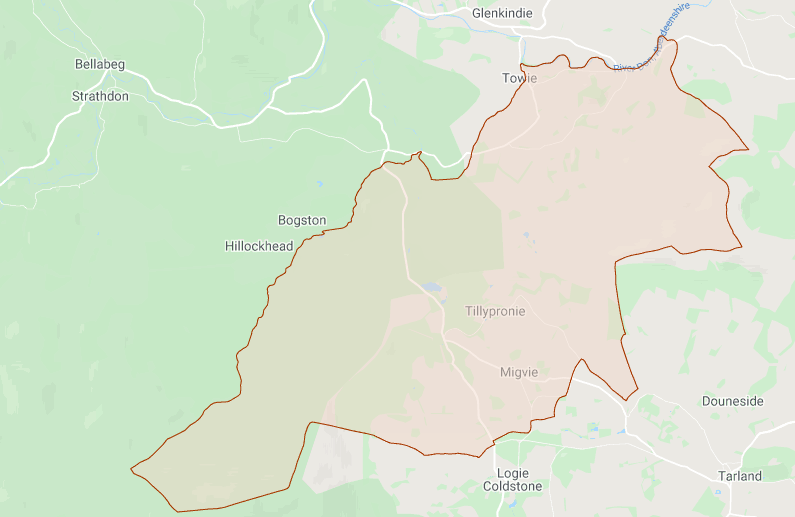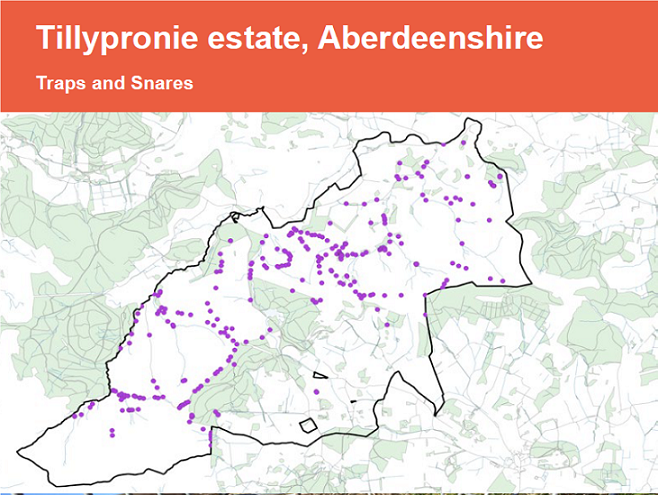Little did I know when blogging about the Cairngorms National Park wildlife sinkhole (see here) that the League of Cruel Sports was going to publish their report, Calculating Cruelty (see here), on 14th August. The Report, if you have not seen it, is a based on a comprehensive field survey of seven estates. From this it is estimated that annually in Scotland “a quarter of a million animals are killed each year in an attempt to totally eradicate foxes, stoats, weasels, along with any other animal that indiscriminately fall into the traps and snares”.
Two of the seven estates surveyed, Invermark and Tillypronie, lie partially within the Cairngorms National Park:


The most intensive trapping at Invermark is in the more accessible part of the estate which lies just outside the National Park boundary. (Remoteness offers protection to animals from gamekeepers which is one of the reasons why it is so important the Cairngorms National Park Authority stops the proliferation of bullodozed tracks). The number of traps and snares recorded by the survey may be lower than on the neighbouring Millden Estate, which lies entirely outside the National Park, but it would appear significant numbers of animals are being killed each year. The Cairngorms National Park Authority, which has a statutory duty to put conservation first, should know how many, but better not to find out about something which is impossible to justify.


At Tillypronie, the most intensive trapping appears to take place inside the National Park boundary, a reflection that this forms the most important moorland on the estate.
They may not be the worst estates featured in the report but the level of trapping and intensity of estate management at Invermark and Tillypronie appears significantly higher than a couple of other estates covered by the survey. Not what anyone should expect from a National Park.
Parkswatch has previously criticised the level of trapping that is taking place in the Cairngorms National Park (see here), (here) and (here). The evidence suggests that the numbers of animals being exterminated across much of the National Park is significantly higher than the Scottish average. I have previously argued the Cairngorms National Park Authority could use its conservation byelaw making powers to ban or strictly limit trapping (see here). So far the CNPA has done nothing to progress this.
The CNPA shouldn’t be waiting until the Environment Secretary, Roseanna Cunningham, announces the Scottish Government’s response to the Werritty Review into grouse moor management (see here). Last week she was forced to promise she would do in the Autumn (see here). That just promises more delay. The CNPA could start by committing to make public the level of trapping that takes place in the National Park, rather than trying to work behind the scenes to influence landowners, as it is attempting to do through the east Cairngorms Moorland Partnership (see here). That has no chance of working while the current system, designed to promote numbers of red grouse at the expense of everything else, remains in place.
What is the way forward?
The solution to the destructive impacts of intensive grouse moor management advocated by the RSPB (see here) and some conservation organisations, the licensing of grouse moors, is unlikely to provide any short-term solutions that are fit for a National Park. In case after case of disappearing raptors, for example, it has proved impossible to prove who has been responsible. That would not change under a licensing scheme and any licensing authority would be left with the thankless and almost impossible task of trying to prove whose license should be revoked.
Nor is waiting for landownership to change a solution. In a welcome development it was revealed on Sunday that one of the estates surveyed, Kildrummy (see here), located just outside the CNPA boundary, has recently changed hands and the new owners intend to manage it for conservation. Since Percy Unna started buying up land for the National Trust for Scotland, we have seen a slow but steady acquisition of sporting estates by conservation minded owners, first non-governmental organisations, now increasingly by the conservation minded very rich, the Rauslings and Povslen’s on this world. They have contributed a great deal but that has not stopped the collapse of hen harrier numbers in Scotland. If hen harriers, weasels, stoats and foxes are allowed to live unpersecuted under the Bently’s at Kildrummy, that will be a welcome improvement, but as soon as that wildlife tries to move into the National Park, there is a very high likelihood it will get killed.
A more radical solution is needed for our National Parks, a ban on all driven up grouse shooting and the intensive estate management that accompanies this (trapping, muirburn, use of medicated grit etc). This would not require the Scottish Government to introduce any new legislation as it could be achieved through the conservation bye-law making powers of our two National Parks.
The Scottish Government could, if it wishes to credibility on wildlife matters, ask the Cairngorms National Park Authority to starting scoping now how such byelaws might work, assess their likely environmental and economic impact and produce proposals that ensure not a single rural job is lost as a consequence. With a little political will, free from landowner influence, far better use could be made of the land in our National Parks, to the benefit of both wildlife and humans.

Every year at about this time (for obvious reasons) the media is full of articles linking management practices for grouse moors to declining wild life, with the the promise of licencing “shortly” – and not just in Scotland. This year is no different (see https://www.theguardian.com/uk-news/2020/aug/12/call-grouse-shooting-licensed-rise-bird-prey-deaths). Last year the Werritty report was news (see https://www.theguardian.com/environment/2019/dec/19/scottish-grouse-moor-owners-face-licensing-within-five-years) with the recommendation of licensing “by 2024” if there wasn’t steady improvement. With reports that wild life crime of all sorts have increased during lockdown – including illegal raptor killing (see https://www.holyrood.com/inside-politics/view,wildlife-crime-when-no-ones-watching_15711.htm) I agree strongly with you – earlier action is required. Hopefully another area in which the Scottish Government can lead the way.
One serious question deserves to be asked: Are more “bucks” still generated and local employment assured from operating seasonal “sporting” estate in the highlands, than would be made by diversifying with fresh priorities ? The re-jigging of these massive land holdings so they might cater even more thoroughly for visitors who come to enjoy the ecology, the open environment- the forests, the hills. To cater for mountaineering, winter sports in season, wildlife appreciation, as well as training for other outdoor leisure pastimes : ( eg: Hangliding, Kayaking, Orienteering, personal development and endurance events, and still others such as residential courses for art, film making and photography) . In this modern age might this not be a more productive use of all these vast spaces. This year due to varying lock-downs and denials of public spaces for leisure the prospect of how to use this asset to benefit more Scots more widely, while encouraging more people to stay and holiday nearer home, is thrown into a fresh Covid-19 induced perspective. No one denies there is plenty of space for this to happen anymore. Very few justifications for the unreal confinement of paring places and denial of hygiene provision that has been permitted to occur, would withstand much scrutiny. As, relentlessly, fresh tracks are driven into wilder regions for ‘ supposed agricultural purposes ‘, and some estates activity encourage the spread of vagrant wild deer, destruction of moorland by fire, and wage open hostility against people who perfectly legally wish to travel along “private” forest roads , “trespass” near waterways kept sacrosanct for fishing , and also endure the sight of hill land cold – redesigned by muirburn to favour only grouse – there is much to discuss.
The “greater good” for Scotland is no longer a static argument at all. The priories can no longer be the ones set by the former patronage principles employed within the Victorian ‘Landed gentry’ era. The dream that “there will always be another rich man coming along ” philosophy that has motivated local conformity to individual land holders is eroding as more connections to the outside world make living in remoter places practical again, and big business becomes the faceless Land lord. Today with increasing urbanisation, setting aside vast tracts of marginal land for what were once loosely called ” bloodsports” are dated. Alternatives that would reinstate the ecosystems lost this past 150 years to bloodsport are there to be more fully exploited. They should be.
I’m no expert on agricultural subsidy but Guy Shrubsole described the situation on English grouse moors as public hand outs for ecological destruction. I suspect and to a limited extent know that the situation in Scotland is similar. I recall one landowner in the Highlands bragging about how much money he got from simply owning land. It’s Robin Hood in reverse where ordinary folks subsidise rich estate owners through the CAP simply for owning land. We all know when a chunk of upland is grouse moor. It’s effectively a sporting land use, but if a wee track needs to be bulldozed or there’s a whiff of a subsidy in the air then it’s agricultural land- sure you might see a sheep or two but it’s secondary to the sporting use. While I’m no particular fan Brexit offers the opportunity to shake off the CAP which was never designed for the landownership pattern in the UK ( though you might think otherwise if you are a landowner). Now all the talk is about a replacement subsidy system for public goods such as tree planting, natural flood management and support for nature and access more generally. So, I would suggest that if the landowners want our cash they need to produce something more public spirited. Such an approach could include a complete forfeit of any annual subsidy for estates indulging in wildlife persecution. The potential loss of several hundred thousand pounds a year might make some think twice before taking a pot shot at a Hen Harrier.
As someone living within one of the two CNPA highlighted in the report I would very much welcome an overhaul of the current systems which promote the destruction of the land. This estate, not content with creating a mono culture in favour of grouse on the higher ground has now also started wiping out everything in the lower fields too. All biodiversity is poisoned or cut down to make everything neat for shooting parties. Public access is made as difficult as possible with electric fences installed everywhere, gates welded shut or padlocked. There are now no wader or ground nesting birds to be seen. Any surviving wildlife if not driven out by reduction of their habitat are shot or trapped. I found a fenn trap on a dyke just yesterday. There seemed to be a strangely high number of dead gulls in the nesting areas beside the newly rebuilt grouse butts on the high ground a coincidence?
We need to move on from this outdated Victorian estate model which encourages aggressive external landowners who think nothing of depleting everything in order to preserve their precious grouse
So the land gets burned and 250 000 animals are slowly murdered before the entitled toffs add their share Scotland’s national disgrace
Lulu, have you reported the dead gulls to the Police?
Yes we have.
Lulu reminds me of the point about it nor just been grouse and the uplands, the valleys in these areas are often stocked intensively with pheasants- they are brought in from intensive units and kept in pens and don’t get much freedom and are still poor fliers when the guns arrive, but it’s another reason for not wanting raptors around, there are often so many of them (thousands) they can have some effect on the habitat. On the gulls I recall there was an incident on Glenbuchat Estate- on the other side of the Don from Tillypronie involving gulls back around 2005 or 6, followed a decade later by a gamekeeper from Kildrummy being jailed for persecution of a couple of Goshawks and a Buzzard.